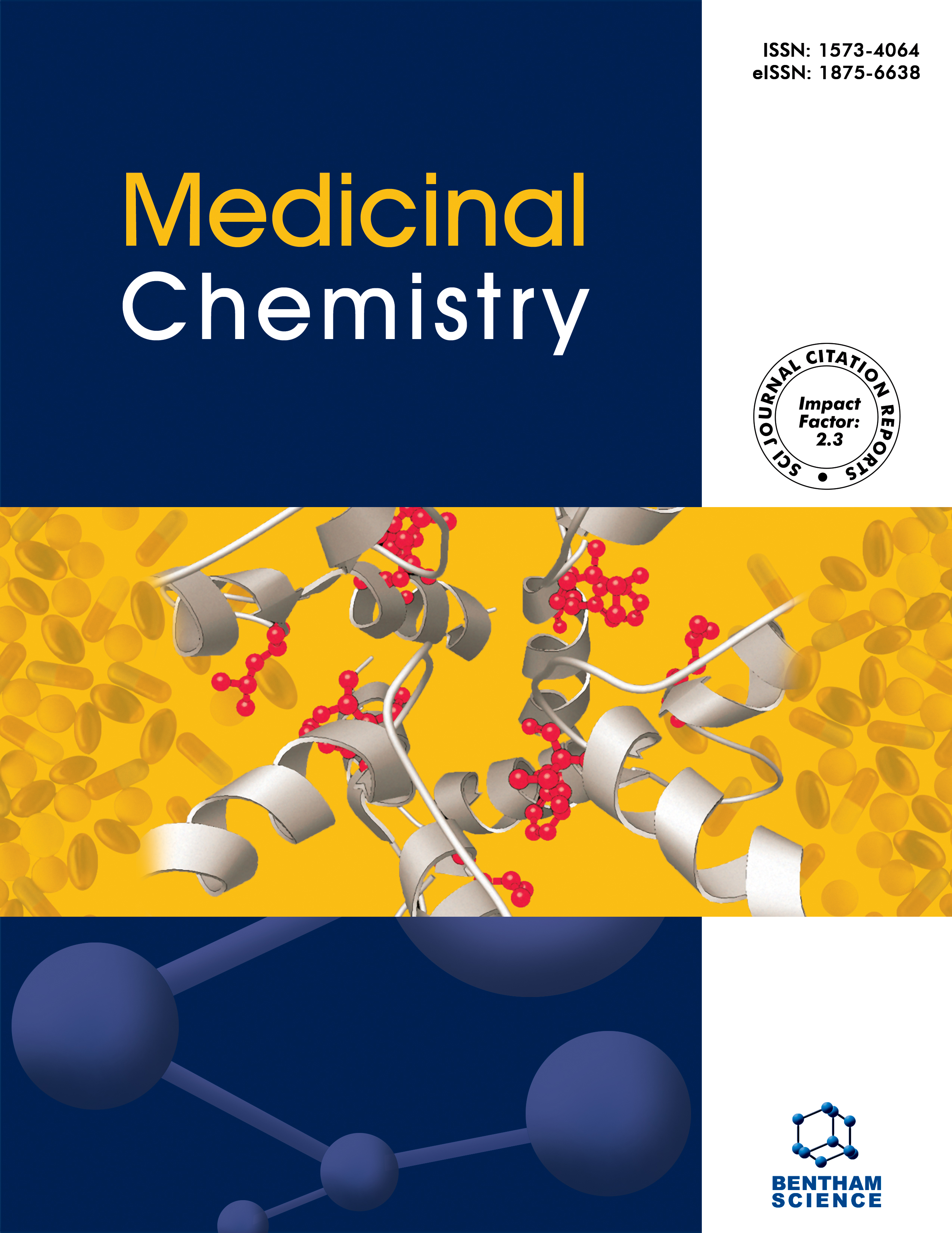- Home
- A-Z Publications
- Medicinal Chemistry
- Previous Issues
- Volume 17, Issue 4, 2021
Medicinal Chemistry - Volume 17, Issue 4, 2021
Volume 17, Issue 4, 2021
-
-
New Approaches in Sensing and Targeting Bacterial rRNA A-site
More LessAuthors: Preethi Parameswaran, Nihar Ranjan and Swaran J.S. FloraNew chemical agents that could combat increasing antibiotic resistance are urgently needed. In this mini-review, an old but highly relevant RNA sequence which is crucial for the continuation of bacterial life-cycle is covered. Some of the most significant advances of the last decade in sensing and targeting the bacterial rRNA A-site: a well-validated binding site of proverbially known aminoglycoside antibiotics are described. So Read More
-
-
-
Xanthone: A Promising Antimycobacterial Scaffold
More LessBackground: Tuberculosis (TB) is one of the infectious diseases associated with high rate of morbidity and mortality and still remains one of the top-ten leading causes of human death in the world. The development of new anti-TB drugs is mandatory due to the existence of latent infection as well as the expansion of the resistant Mycobacterium tuberculosis (MBT) strains. Xanthones encompass a wide range of structurally diverse Read More
-
-
-
The Interaction of Schistosoma Japonicum Glutathione Transferase with Cibacron Blue 3GA and its Fragments
More LessBackground: The 26kDa glutathione transferase (GST, EC 2.5.1.18) from Schistosoma japonicum (SjGST) is recognized as the major detoxification enzyme of S. japonicum, a pathogenic helminth causing schistosomiasis. Objective: In the present study, the interaction of the chlorotriazine dye Cibacron blue 3GA (CB3GA) and its structural analogues with SjGST was investigated. The work aimed to shed light on the non-substrate Read More
-
-
-
Novel Aminopyrazole Tagged Hydrazones as Anti-Tubercular Agents: Synthesis and Molecular Docking Studies
More LessBackground: Pyrazole derivatives have been reported to possess numerous pharmacological activities viz., anti-inflammatory, antipsychotic, etc. Our group has disclosed that pyrazole benzamides display potent antibacterial and anti-tubercular activities. Objective: Synthesis of new pyrazole acetamides which possess hydrazone group to be evaluated for antitubercular activity. Methods: The key intermediate 5-aminopyrazole Read More
-
-
-
Design, Synthesis, Pharmacological Evaluation, In silico Modeling, Prediction of Toxicity and Metabolism Studies of Novel 1-(substituted)-2-methyl- 3-(4-oxo-2-phenyl quinazolin-3(4H)-yl)isothioureas
More LessAuthors: Mohaideen T. Sulthana, Veerachamy Alagarsamy and Krishnan ChitraBackground: Although exhaustive efforts to prevent and treat tuberculosis (TB) have been made, the problem still continues due to multi-drug-resistant (MDR) and extensively drugresistant TB (XDR-TB). It clearly highlights the urgent need to develop novel “druggable” molecules for the co-infection treatment and strains of MDR-TB and XDR-TB. Objective: In this approach, a hybrid molecule was created by merging two or m Read More
-
-
-
Synthesis, Anticancer, and Antibacterial Studies of Benzylidene Bearing 5-substituted and 3,5-disubstituted-2,4-Thiazolidinedione Derivatives
More LessAuthors: Navjot S. Sethi, Deo N. Prasad and Rajesh K. SinghAim: To develop novel compounds having potent anticancer and antibacterial activities. Background: Several studies have proved that benzylidene analogues of clinical 2,4-TZDs, such as troglitazone and ciglitazone, have more potent antiproliferative activity than their parent compounds. Literature studies also revealed that the attachment of more heterocyclic rings, containing nitrogen on 5th position of 2,4-TZD, can enh Read More
-
-
-
In silico Study to Evaluate the Antiviral Activity of Novel Structures against 3C-like Protease of Novel Coronavirus (COVID-19) and SARS-CoV
More LessBackground: Globally, over 4.3 million laboratory confirmed cases of COVID-19 have been reported from over 105 countries. No FDA approved antiviral is available for the treatment of this infection. Zhavoronkov et al., with their generative chemistry pipeline, have generated structures that can be potential novel drug-like inhibitors for COVID-19, provided they are validated. 3C–like protease (3CLP) is a homodimeric cysteine Read More
-
-
-
Quantitative Structure Activity/Pharmacokinetics Relationship Studies of HIV-1 Protease Inhibitors Using Three Modelling Methods
More LessAuthors: Dan Han, Jianjun Tan, Jingrui Men, Chunhua Li and Xiaoyi ZhangBackground: HIV-1 protease inhibitor (PIs) is a good choice for AIDS patients. Nevertheless, for PIs, there are several bugs in clinical application, like drug resistance, the large dose, the high costs and so on, among which, the poor pharmacokinetics property is one of the important reasons that leads to the failure of its clinical application. Objective: We aimed to build computational models for studying the relationship between PI Read More
-
-
-
Site-directed Fragnomics and MD Simulations Approaches to Identify Interleukin-2 Inhibitors
More LessAuthors: Ruqaiya Khalil, Saman Usmani, Mohammad Nur-e-Alam, Sarfaraz Ahmed and Zaheer Ul-HaqIntroduction: The aberrant expression of Interleukin-2 (IL2), the chief regulator of immunity, is associated with many auto-immune diseases. At present, there is no FDA approved drug targeting IL2, which puts forth the need for small molecular inhibitors to block IL2 and its receptor interaction. Methodology: Herein, we used the contemporary fragnomics approach to design novel drug-like inhibitors targeting IL2. Brie Read More
-
-
-
Exploring the Molecular Mechanisms of 17β-HSD5-induced Carcinogenicity of Catha edulis via Molecular Modeling Approach
More LessBackground: The tradition of khat chewing has been deep-rooted in the African and Arabian Peninsula for centuries. Due to its amphetamine-like psycho-stimulant or euphoric effect, khat has been used by millions in Somalia, Ethiopia, Saudi Arabia and Yemen. The long-term use of khat can induce many major health outcomes, which may be serious and irreversible. Objective: Prolonged use of khat constituents has been ass Read More
-
Volumes & issues
-
Volume 21 (2025)
-
Volume 20 (2024)
-
Volume 19 (2023)
-
Volume 18 (2022)
-
Volume 17 (2021)
-
Volume 16 (2020)
-
Volume 15 (2019)
-
Volume 14 (2018)
-
Volume 13 (2017)
-
Volume 12 (2016)
-
Volume 11 (2015)
-
Volume 10 (2014)
-
Volume 9 (2013)
-
Volume 8 (2012)
-
Volume 7 (2011)
-
Volume 6 (2010)
-
Volume 5 (2009)
-
Volume 4 (2008)
-
Volume 3 (2007)
-
Volume 2 (2006)
-
Volume 1 (2005)
Most Read This Month
Article
content/journals/mc
Journal
10
5
false
en


